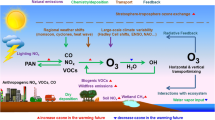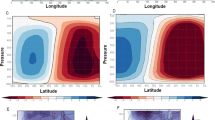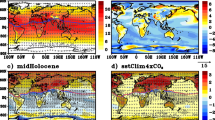Abstract
The annual variation in planetary boundary layer (PBL) height is determined from the profiles of conserved thermodynamic variables, i.e., virtual potential temperature θ v and equivalent potential temperature θ e, using radiosonde data at per-humid climate region, Ranchi (23°42′N, 85°33′E, 610 m asl) and semi-arid region, Anand (23°35′N, 72°55′E, 45.1 m asl), India. Of all the variables, the θ v profile seems to provide the most reasonable estimate of the PBL height. This has been supplemented by T-Phi gram analysis for specific days. It has been found that in winter the height of boundary layer is very low due to subsidence and radiational cooling, while pre-monsoon months exhibit the most variable convection. It may be inferred that synoptic conditions accompanied by a variety of weather phenomena such as thunderstorms, onset and withdrawal of monsoons, etc. control the ABL over Ranchi, while daytime solar insolation and nighttime radiative cooling mainly control the ABL over Anand.





Similar content being viewed by others
References
Awadhesh Kumar A (1992) Climatological study of thunderstorms at Lucknow airport. Mausam 43:441
Betts AK (1982) Saturation point analysis of moist convective overturning. J Atmos Sci 39:1484–1505
Betts AK, Albrecht BA (1987) Conserved variable analysis of the convective boundary layer thermodynamic structure over the tropical oceans. J Atmos Sci 44:83–99
Coulter RL (1979) A comparison of three methods for measuring mixing-layer height. J Appl Meteorol 18:1495–1499
Devera PCS, Ernest Raj P, Murthy BS, Pandithurai G, Sharma S, Vernekar KG (1995) Intercomparison of nocturnal lower-atmospheric structure observed with Lidar and Sodar techniques at Pune, India. J Appl Meteorol 34:1375–1383
Devera PCS, Maheshmumar RS, Murthy BS, Vernekar KG (1997) Air-quality monitoring by optical and acoustic radars at Pune, India. Meas Sci Technol 8:1160–1165
Garratt JR (1990) The internal boundary layer—a review. Bound Layer Meteorol 50:171–203
Gryning SE, Holtslag AAM, Irwin JS, Sivertsen B (1987) Applied dispersion modelling based on meteorological scaling parameters. Atmos Environ 21:79–89
Joseph PV (1982) A tentative model of Aandhi. Mausam 33:417
Kevin AK, Bruce AA (1989) Low-level inversions over the tropical pacific-thermodynamic structure of the boundary layer and above-inversion moisture structure. Mon Weather Rev 117:87–101
Krishnamurthy V (1965) A statistical study of thunderstorms over Poona. Indian J Meteorol Geophys 16:484
Kumar M, Gupta BRD, Shekh AM, Pandey V, Patel HR (2001) Assessment of surface radiation components at LASPEX sites. J Agromet 3(1&2):79–87
Litta AJ, Mohanty UC (2008) Simulation of a severe thunderstorm event during the field experiment of STORM programme using WRF-NMM model. Curr Sci 95(2):204–215
Murthy BS, Parasnis SS (2001) On estimating the convective boundary layer height during the monsoon period. J Agrometeorol 3(1&2):287–298
Murthy BS, Dharmraj T, Vernekar KG (1996) Sodar observations of the nocturnal boundary layer at Kharagpur, India. Bound Layer Meteorol 81:201–209
Nagar SG, Tyagi A, Seetaramayya P, Singh SS (2000) Evolution of an atmospheric boundary layer at a tropical semi-arid station Anand during boreal summer month of May–a case study. Curr Sci 78(5):595–600
Parasnis SS, Morwal SB (1994) A convectively driven boundary layer in the monsoon trough. Bound Layer Meteorol 71:197–204
Parasnis SS, Kulkarni MK, Pillai JS (2001) Simulation of boundary layer parameters using one dimensional atmospheric boundary layer model. J Agrometeorol 3(1&2):261–266
Rao KN, Raman PK (1961) Frequency of days of thunder in India. Indian J Meteorol Geophys 16:103
Sadani LK, Murthy BS (1996) Estimation of surface heat flux and inversion height with a Doppler acoustic sounder. Proc Indian Acad Sci (Earth Planet Sci) 105:289–307
Seetaramayya P, Tyagi A, Nagar SG, Murthy BS (2001) Comparison of PBL structure between pre-monsoon, monsoon season at Anand during 1997. J Agrometeorol 3(1&2):267–274
Seibert P, Beyrich F, Gryning SE, Joffre S, Rasmussen A, Tercier P (1998) Mixing layer depth determination for dispersion modelling. In: COST Action 710—Final Report. Harmonisation of the pre-processing of meteorological data for atmospheric dispersion models, Report of Working Group 2. Office for Official Publications of the European Communities, Luxembourg
Seibert P, Beyrich F, Gryning SE, Joffre S, Rasmussen A, Tercier P (2000) Review and intercomparison of operational methods for the determination of the mixing height. Atmos Environ 34:1001–1027
Stull RB (1991) Static stability–an update. Bull Amer Meteorol Soc 72:10
Vishwanathan TR, Faria JF (1962) A climatological study of thunderstorms at Bombay airport, Indian. J Met Geophys 13:377
Acknowledgments
The present piece of work is a part of the work done during the Department of Science and Technology, Government of India-sponsored project under its coordinated field research program on CTCZ. Therefore, the authors are thankful to the Department of Science and Technology, Government of India for providing the funding. The authors are also thankful to the Gujarat Agricultural University, Anand (now Anand Agricultural University) for providing the data collected from land surface processes experiment (LASPEX-97), which was also financed by the DST, New Delhi.
Author information
Authors and Affiliations
Corresponding author
Rights and permissions
About this article
Cite this article
Kumar, M., Kumar, A., Mallik, C. et al. Daytime boundary layer behavior over eastern region (per-humid climate) and western regions (semi-arid climate) of India: a case study. Meteorol Atmos Phys 111, 55–64 (2011). https://doi.org/10.1007/s00703-010-0116-6
Received:
Accepted:
Published:
Issue Date:
DOI: https://doi.org/10.1007/s00703-010-0116-6




